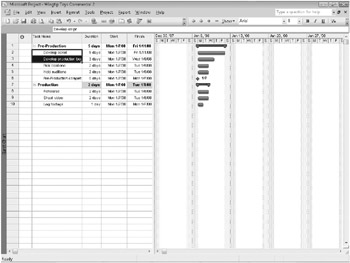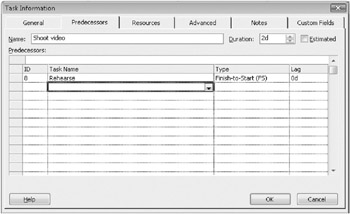Linking Tasks
Projects require tasks to be performed in a specific order. For example, the task of filming a scene must be completed before the task of editing the filmed scene can occur. These two tasks have a finish-to-start relationship (also called a link or dependency) that has two aspects:
-
The second task must occur later than the first task; this is a sequence.
-
The second task can occur only if the first task is completed; this is a dependency.
In Project, the first task (“film the scene”) is called the predecessor because it precedes tasks that depend on it. The second task (“edit the filmed scene”) is called the successor because it succeeds tasks on which it is dependent. Any task can be a predecessor for one or more successor tasks. Likewise, any task can be a successor to one or more predecessor tasks.
Although this might sound complicated, tasks can have one of only four types of task relationships.
| This task relationship | Means | Looks like this in the Gantt chart | Example |
|---|---|---|---|
| Finish-to-start (FS) | The finish date of the predecessor task determines the start date of the successor task. | | A film scene must be shot before it can be edited. |
| Start-to-start (SS) | The start date of the predecessor task determines the start date of the successor task. | | Reviewing a script and developing the script breakdown and schedule are closely related, and they should occur simultaneously. |
| Finish-to-finish (FF) | The finish date of the predecessor task determines the finish date of the successor task. | | Tasks that require specific equipment must end when the equipment rental ends. |
| Start-to-finish (SF) | The start date of the predecessor task determines the finish date of the successor task. | | The time when the editing lab becomes available determines when a pre-editing task must end. (This type of relationship is rarely used.) |
Representing task relationships and handling changes to scheduled start and finish dates is one area in which the use of a scheduling engine, such as Project, really pays off. For example, you can change task durations or add or remove tasks from a chain of linked tasks, and Project will reschedule tasks accordingly.
Task relationships appear in several ways in Project:
-
In the Gantt Chart and Network Diagram views, task relationships appear as the lines connecting tasks.
-
In tables, such as the Entry table, task ID numbers of predecessor tasks appear in the Predecessor fields of successor tasks.
You create task relationships by creating links between tasks. Currently, all of the tasks in the project plan are scheduled to start on the same day-the project start date. In this exercise, you use different methods to create links between several tasks, thereby creating finish-to-start relationships.
First you’ll create a finish-to-start dependency between two tasks.
1. Select the names of tasks 2 and 3.

2. On the Edit menu, click Link Tasks.
| Tip | To create a finish-to-start dependency, you can also click the Link Tasks button on the Standard toolbar. |
Tasks 2 and 3 are linked with a finish-to-start relationship. Note that Project changed the start date of task 3 to the next working day following the completion of task 2 (skipping over the weekend), and the duration of the Pre-Production summary task grew correspondingly.

| Tip | To unlink tasks, select the tasks you want to unlink, and then click the Unlink Tasks button on the Standard toolbar. You can also click Unlink Tasks on the Edit menu. If you unlink a single task that is within a chain of linked tasks with finish-to-start relationships, Project reestablishes links between the remaining tasks. |
Next, you will link several tasks at once.
3. Select the names of tasks 3 through 6.
4. On the Edit menu, click Link Tasks.
Tasks 3 through 6 are linked with a finish-to-start relationship.

Have you noticed the blue highlighting of some of the Duration, Start, and Finish fields as you linked tasks? Project highlights the values that are affected after each change you make in a project plan. This feature is called Change Highlighting, and you can turn it off or on via the View menu.
Next, you will link two tasks in a different way by making task 8 the predecessor of task 9.
5. Select the name of task 9.
6. On the Project menu, click Task Information.
| Tip | You can also click the Task Information button on the Standard toolbar. |
The Task Information dialog box appears.
7. Click the Predecessors tab.
8. Click the empty cell below the Task Name column heading, and then click the down arrow that appears.
9. On the Task Name list, click Rehearse, and press ![]() .
.

10. Click OK to close the Task Information dialog box.
Tasks 8 and 9 are linked with a finish-to-start relationship.
To finalize this exercise, you’ll link the remaining production tasks and then link the two summary tasks.
11. Select the names of tasks 9 and 10.
12. On the Edit menu, click Link Tasks.
13. Select the name of task 1 and, while holding down the ![]() key, select the name of task 7. This is how you make a nonadjacent selection in a table in Project.
key, select the name of task 7. This is how you make a nonadjacent selection in a table in Project.
14. On the Edit menu, click Link Tasks to link the two summary tasks.
| Tip | When working with summary tasks, you can either link summary tasks directly (as you did above) or link the latest task in the first phase with the earliest task in the second phase. The scheduling end result is the same in either situation, but it’s preferable to link the summary tasks to better reflect the sequential nature of the two phases. Under no circumstances, however, can you link a summary task to one of its own subtasks. Doing so would create a circular scheduling problem, and therefore Project doesn’t allow it. |
15. If needed, scroll the chart portion of the Gantt Chart view to the right until the second phase of the project plan is visible.

| Tip | You can also create a finish-to-start relationship between tasks right in the Gantt chart. Point to the task bar of the predecessor task until the pointer changes to a four-pointed star. Then, drag the mouse pointer up or down to the task bar of the successor task. While you’re dragging the mouse pointer to create a task relationship, the pointer image changes to a chain link. |
EAN: 2147483647
Pages: 247